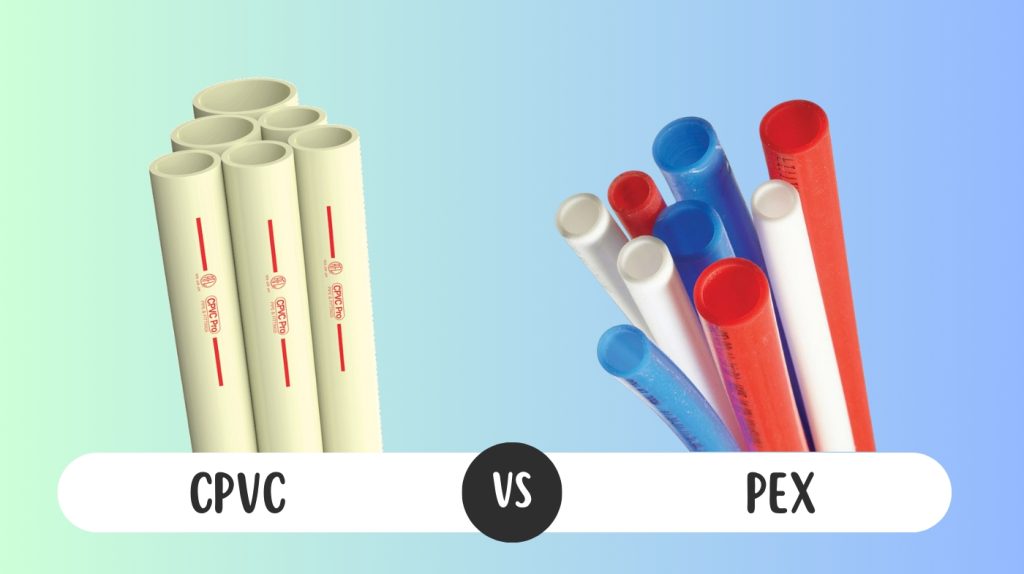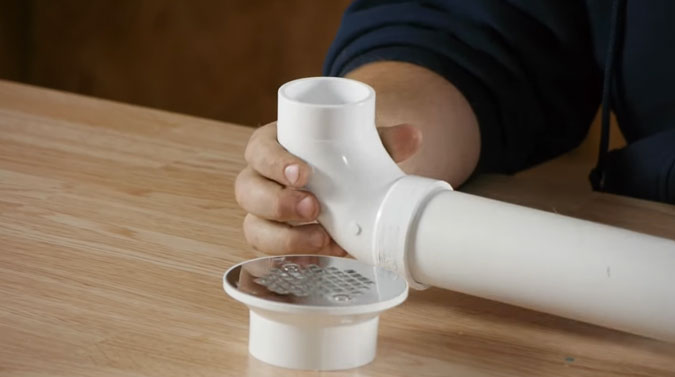Last Updated on April 13, 2025
When comparing CPVC and PEX, consider their unique advantages. CPVC offers excellent heat and chemical resistance, making it ideal for high-temperature applications, while PEX provides flexibility in installation and better freeze resistance.
CPVC resists biofilm growth and guarantees water quality, but PEX’s ease of installation can reduce labor costs. Both materials are recyclable and have specific strengths regarding pressure ratings and durability.
For a more thorough view of their performance differences, continue to explore further details.
Key Takeaways
- CPVC offers superior chlorine resistance and corrosion protection, making it ideal for water treatment and high-temperature applications.
- PEX provides greater flexibility and ease of installation, reducing the number of fittings required in tight spaces.
- CPVC typically has higher pressure ratings and delivers better water flow due to its larger internal diameter.
- PEX is more resistant to freezing conditions, while CPVC resists biofilm growth better and minimizes contamination.
- Both materials are recyclable, though PEX generally results in less installation waste and has a lower carbon footprint.
Material Composition and Characteristics
When comparing CPVC and PEX, understanding their material composition and characteristics is crucial.
CPVC is made by chlorinating PVC, which enhances its heat and chemical resistance, making it ideal for hot and cold water lines. In contrast, PEX, or cross-linked polyethylene, offers increased durability and flexibility, suitable for various plumbing applications.
CPVC pipes exhibit inherent chlorine resistance, which makes them suitable for water treatment systems. CPVC performs exceptionally well under high temperatures and resists chlorine, while PEX is more flexible and better at handling freezing conditions.
However, PEX has a lower resistance to chlorine compared to CPVC. CPVC excels in high temperatures and chlorine resistance, while PEX offers flexibility and superior freeze handling.
Both materials resist corrosion, but their mechanisms differ. Ultimately, choosing between them involves considering their unique properties and intended application to guarantee peak performance in your plumbing system.
Installation and Cost Comparison
While both CPVC and PEX have their advantages, the installation process and associated costs can considerably influence your choice.
PEX’s flexibility allows for easier navigation in tight spaces, requiring fewer fittings and reducing installation time. In contrast, CPVC’s rigidity necessitates more fittings and can complicate the installation, especially in corners.
Although CPVC materials may initially seem cheaper, the labor-intensive installation can drive up overall costs. PEX not only saves on labor but also minimizes long-term maintenance expenses due to its lower leak risk. Furthermore, its flexibility allows for better adaptability in various installation scenarios, which can be a significant benefit.
Additionally, PEX can be air-tested before water introduction, enhancing system reliability. Overall, if ease of installation and cost-efficiency are priorities, PEX might be the better choice.
Water Quality and Durability
When considering water quality and durability, evaluate how CPVC and PEX handle biofilm formation and chlorine degradation. CPVC pipes resist biofilm development and chlorinated environments better than PEX, which can degrade quickly under similar conditions.
Additionally, CPVC offers superior corrosion resistance, ensuring a longer lifespan for your plumbing system. Furthermore, FlowGuard Plus CPVC is the most installed plumbing system brand, reflecting its reliability and trust in maintaining water quality.
Biofilm Formation Resistance
Given the critical role of biofilm formation in water quality and system durability, CPVC pipes stand out as a superior choice for plumbing applications.
With a lower biofilm formation potential than PEX, CPVC enhances water quality and hygiene. Its material properties effectively discourage bacterial colonization, resulting in fewer contaminants in your water supply.
Biofilm resistance is essential for the health and safety of all water users, making CPVC a wise investment. Comparative studies consistently show CPVC outperforming PEX, particularly in reducing Legionella bacteria counts.
The non-permeable nature of CPVC also prevents contamination, ensuring compliance with NSF 61 standards for safe drinking water. Furthermore, the smooth surface of CPVC pipes facilitates efficient water flow, further minimizing biofilm accumulation.
Chlorine Degradation Resistance
The ability of plumbing materials to withstand chlorine exposure considerably impacts water quality and system longevity.
CPVC shows remarkable resilience against chlorine, ensuring durability for decades, while PEX is vulnerable to degradation, particularly in high-temperature or high-chlorine environments.
Additionally, CPVC’s superior resistance to chlorine makes it a preferred choice for systems that require long-term reliability in chlorinated water applications.
| Material | Chlorine Resistance | Service Life |
|---|---|---|
| CPVC | High, up to 60+ years | Long-term reliability |
| PEX | Limited, up to 4.3 ppm | Shortened lifespan |
| CPVC | Superior under pressure | Consistent performance |
| PEX | Degradation risk elevated | Frequent replacements |
| CPVC | Chemically immune | Safe for treatment |
Corrosion Resistance Comparison
While both CPVC and PEX demonstrate superior corrosion resistance compared to traditional materials like copper, their performance varies considerably with regard to water quality and durability.
CPVC is more chemically inert, making it less reactive to water treatment chemicals, which helps maintain better water quality and aesthetics. Studies indicate that CPVC has a minimal impact on water quality, while PEX may leach chemicals under specific conditions.
Additionally, PEX is known for its flexible nature, which allows for easier installation in tight spaces, though this may not directly influence water quality. In relation to lifespan, CPVC typically lasts 50 to 75 years, outperforming PEX, which lasts around 40 to 50 years.
Although both materials resist corrosion effectively, CPVC often excels in environments with harsh chemicals, ensuring long-term durability and reliability for your plumbing needs.
Pressure and Flow Performance
Pressure and flow performance are critical factors when choosing between CPVC and PEX for plumbing systems.
CPVC typically boasts higher pressure ratings, often reaching 400 psi at room temperature, while PEX maxes out at 160 psi. The presence of chlorine in water reduces PEX’s temperature tolerance, further limiting its pressure performance.
Additionally, CPVC’s immunity to chlorine ensures its durability and consistent performance in chlorinated water systems. Regarding flow, CPVC’s larger internal diameter provides greater water delivery, especially beneficial in fire protection systems.
PEX fittings, however, can cause a 23% to 54% flow reduction due to diameter constriction. Additionally, CPVC fittings result in minimal pressure drops (about 0.3 psi), compared to PEX’s 2 to 3 psi.
Failure Rates and Reliability
When evaluating failure rates and reliability, it’s essential to take into account various factors that can influence the longevity and performance of CPVC and PEX pipes.
Manufacturing defects and installation errors can lead to premature failures in both types. PEX is more resistant to freezing damage but may degrade due to oxidative stress, while CPVC generally offers greater resistance to such degradation.
Studies suggest PEX often has a lower failure rate under certain conditions, yet CPVC can last longer in chlorinated water. The age of pipes, water quality, and environmental conditions greatly impact reliability.
Additionally, forensic analysis data suggests PEX has a higher reliability compared to CPVC based on comprehensive evaluations.
Environmental and Chemical Resistance
Reliability in piping systems often hinges on the materials’ environmental and chemical resistance characteristics. PEX and CPVC both offer recyclability, reducing waste, but PEX typically has a lower carbon footprint due to minimal installation waste.
Reliability in piping systems depends on the environmental and chemical resistance of materials like PEX and CPVC.
When it comes to chemical resistance, CPVC excels, resisting chlorine and minimizing biofilm growth, while PEX can degrade under certain conditions.
Additionally, CPVC’s lower likelihood of leaching chemicals helps maintain water purity. Furthermore, both materials are approved for use in fire sprinkler systems, ensuring they meet safety standards.
However, PEX demonstrates superior freeze resistance and flexibility, making it adaptable in various environments. UV exposure poses a risk to PEX, necessitating protective measures during installation.
Frequently Asked Questions
What Are the Typical Applications for CPVC and PEX Pipes?
CPVC and PEX pipes are widely used in various applications. You’ll find CPVC in residential plumbing for hot and cold water systems, HVAC setups, and industrial settings due to its temperature and chemical resistance.
PEX, on the other hand, is ideal for residential plumbing as well, thanks to its flexibility and ease of installation. It’s particularly beneficial in areas prone to freezing temperatures, making it a practical choice for many homeowners.
How Do CPVC and PEX Compare in Terms of Lifespan?
Imagine your plumbing system as a lifeline, carrying water through your home. When it comes to lifespan, CPVC generally outlasts PEX under ideal conditions, especially in high temperatures.
While PEX offers flexibility and ease of installation, it can degrade when exposed to chlorinated water. Conversely, CPVC’s durability shines in environments requiring chemical resistance.
Can CPVC and PEX Be Used for Outdoor Plumbing?
Yes, CPVC and PEX can be used for outdoor plumbing, but each has limitations. CPVC is durable and can handle high temperatures, but it needs UV protection to prevent degradation.
On the other hand, PEX is flexible and easier to install, yet it’s sensitive to UV light and should stay shaded or buried. When using either material outdoors, guarantee proper installation and protective measures to mitigate environmental risks and maintain performance.
How Do Temperatures Affect the Performance of CPVC and PEX?
When you’re working with plumbing, temperature fluctuations greatly affect performance. CPVC expands with external temperature changes, while PEX remains flexible but loses its pressure rating in chlorinated water above 140°F (60°C).
Both materials have unique thermal expansion properties, so understanding these limits is essential for ensuring a reliable plumbing system in varying temperature conditions.
What Maintenance Is Required for CPVC and PEX Systems?
To maintain your plumbing system, regularly inspect for leaks and signs of wear. For CPVC, check joints and fittings for corrosion and replace any damaged sections.
With PEX, verify that connections are secure, and watch for any signs of UV exposure if installed in direct sunlight.
Both systems benefit from flushing to eliminate sediment buildup, and you should also periodically check for any unusual water quality issues to guarantee peak performance.
Durability or Flexibility? Make the Right Choice for Your Pipes
In choosing between CPVC and PEX, consider your specific needs and priorities. CPVC offers solid durability and chemical resistance, while PEX provides flexibility and ease of installation.
Think of your plumbing system as a lifeline—each material plays an essential role in maintaining its flow.
Ultimately, whether you opt for the strength of CPVC or the adaptability of PEX, you’ll guarantee a reliable, efficient water delivery system that stands the test of time.


